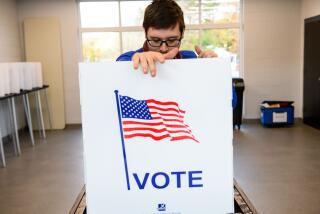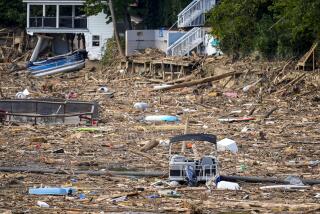Weary, Fed-Up Floridians Brace for Fourth Hurricane
- Share via
PLANTATION, Fla. — First came Charley, then Frances, then Ivan. On Friday, storm-tossed Floridians were scrambling to get ready for what would be a first for the state: a fourth hurricane this year, called Jeanne, which was threatening to strike early Sunday.
“Annoying? To no end,” said Dullys Gonzalez, 36, a ceiling fan technician. Gonzalez spent an hour re-bolting corrugated steel shutters to his one-story home here that he had put up, then removed, this month for Frances.
“Never do they exactly know where these storms are going,” he said, “and that’s the frustrating thing.”
Authorities asked 750,000 residents of Atlantic barrier islands, mobile homes and low- lying areas to move to safer ground. Mandatory evacuation orders were expected today in many areas still recovering from Frances, which made landfall Sept. 5.
“I know people are frustrated. I know they are tired of all this,” said Gov. Jeb Bush. “Trust me, the governor is as well.”
Jeanne, on course to become the fourth hurricane to strike Florida in a little over six weeks, killed more than 1,100 people in Haiti last weekend with driving rains and widespread flooding.
At 11 p.m. EDT Friday, the storm was about 315 miles east of the southeast coast of Florida, and it was plowing westward through the Atlantic at 12 mph, the National Hurricane Center in Miami said. Jeanne, with sustained winds of near 100 mph, was a Category 2 hurricane on a five-step intensity scale and was expected to strengthen in the next 24 hours. Forecasters said conditions were favorable for Jeanne to become a major hurricane before landfall.
The storm’s center was expected to pass over or near the northwestern Bahamas today, and could reach Florida early Sunday. One possible landfall site, said meteorologist Dan Brown, was the same stretch of Atlantic beaches, known as the Treasure Coast, that was pounded by Frances on Labor Day weekend.
A hurricane warning was posted Friday for virtually the entire Atlantic shoreline of Florida, from Florida City south of Miami to St. Augustine, meaning hurricane conditions could occur anywhere there within 24 hours. Jeanne’s hurricane-force winds were extending 70 miles from its eye.
On Florida’s east coast, many people were going about the now all-too-familiar rituals of stocking up on water and food, filling their gas tanks and rigging their homes to ride out an onslaught of wind and rain.
“We’re so tired, we’re silly,” said Rita Taylor, manager of the Sprint gas station and convenience store in Edgewater, south of Daytona Beach. “We have a parking lot full of cars, people lining up on the street, people fighting for gas.”
Jeanne could strike Florida over the weekend of Yom Kippur, the holiest date on the Jewish calendar, which began at sundown Friday and ends at sundown today. “We are asking those who are keeping their faith and their strict Orthodox practices to prepare early,” Bush said.
In Plantation, Broward County Mayor Ilene Lieberman announced that she was declaring a state of emergency Friday at midday, in part so the county’s large Jewish community would be alerted to the danger and have time to prepare before sundown.
To allow observant Jews to keep abreast of Jeanne without violating religious tenets, which forbid work on the Sabbath and holy days, some rabbis were recommending their congregations turn on their radio before the onset of Yom Kippur and leave it on, said Regina Weinstein, temple secretary at the Sunrise Jewish Center.
To the north, Rabbi Richard Margolis of Temple Beth Shalom in Melbourne said he might have to abbreviate Yom Kippur services so his congregation did not violate a curfew expected to take effect today in areas of Brevard County covered by evacuation order. Many of the 285 households that belong to Beth Shalom live in those areas.
“One of the messages of Yom Kippur is that God is compassionate and understanding,” Margolis said. “And it would certainly be understandable if someone could not attend the synagogue.”
Florida’s hurricanes this year have been blamed for at least 70 deaths in the state and at least $13 billion in damage to insured property. Charley raked the state’s southwest coast Aug. 13 with 145-mph winds. Frances ravaged the Atlantic Coast and the state’s midsection over the Labor Day weekend. On Sept. 16, Ivan caused destruction in Florida’s Panhandle and neighboring areas of Alabama.
Dee Ann Miller, a spokeswoman for the state Emergency Operations Center in Tallahassee, said four hurricanes in one year would be a record for Florida but that officials would be up to the challenge.
“Yes, we’re tired, and our resources are stretched, but we remain committed to our mission of serving the state’s 17 million residents and preparing and responding to all of these storms,” Miller said.
Brown, the meteorologist, said official hurricane archives went back only 130 years or so, but that he had detected no great shift in weather patterns.
“We have had some years that have been just as active as far as the number of storms, but we didn’t see the number of landfalls that we have had this year,” Brown said.
What’s been different in 2004, Brown said, are westerly steering currents and a high-pressure system over the western Atlantic and eastern United States that have sent storms spinning toward Florida and not let them move farther north.
Times researcher Rennie Sloan in Atlanta contributed to this report.
More to Read
Sign up for Essential California
The most important California stories and recommendations in your inbox every morning.
You may occasionally receive promotional content from the Los Angeles Times.










